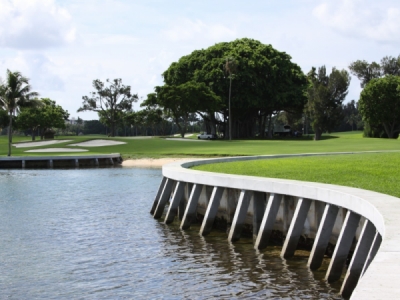
Posted on June 26, 2019
While the calculated economic costs to the entire nation is expected to peak at $416 billion, Florida’s regions are heavily represented in the report’s pages.
MIAMI BEACH, FLORIDA – The provocatively titled report High Tide Tax was released Thursday by the Center for Climate Integrity and claims Florida will have to spend $74 billion in seawall construction in order to prepare for sea level rise by 2040.
Florida ranks number one in the report of all states in the country facing these costs, almost double both of the next ranked Louisiana and North Carolina.
The Center for Climate Integrity, an arm of the Institute for Governance and Sustainable Development, ‘supports litigation and advocacy to hold the fossil fuel industry accountable for their fair share of the escalating costs of adapting to climate change.’
The researchers calculated sea level rise across many regions using their two most conservative scenarios (the researchers purposefully avoided a worst-case assessment) and merged the calculations with a map of targeted public infrastructure, which included amongst others, hospitals, airports, roads, and schools.
The analysts then determined flood risk in these scenarios by counting grids on the map that were inundated with fifteen percent or more flooding and used this determination to consider which areas required seawalls.
While the calculated economic costs to the entire nation is expected to peak at $416 billion, Florida’s regions are heavily represented in the report’s pages. Jacksonville ranks at number one in the state, but is the only Florida community out of seven requiring such a stiff bill.
“Our collective failure to come to grips with the massive costs of climate adaptation is the latest, and most delusional form of climate denial,” said Richard Wiles, Executive Director of the Center for Climate Integrity.
“The cost estimates presented here are just a small portion of the total adaptation costs these local and state governments will be forced to finance,” said Paul Chinowsky, PhD, lead engineer on the project.
However Miami-Dade County, at number 29 and $3.2 billion, is on the list of counties that they project will need to spend more than a billion dollars in seawall construction by 2040, as is Monroe County at number two in the nation with expected costs of $11 billion. Miami Beach is not on the list of communities apparently needing more than a billion dollars in expenditures on seawall construction.
This is likely because seawalls are only a small part if any of resiliency planning for the Miami area. As Florida sits on a porous limestone bedrock, the seas will rise beneath it and seep up through the spongy foundation and unfortunately for residents, seawalls cannot prevent this.

According to scientists, recharging the flow of fresh water down through the Everglades from Lake Okeechobee to create a counter pressure on the rising salt water would be one of the most effective measures against sea level rise, as would restoration of the Biscayne Bay.
The recent report by the U.S. Geological Survey, evaluating Florida’s coral reefs at $1.6 billion as flood protection, also highlights the importance of reef restoration for resiliency.
Moreover, green infrastructure – such as riprap (rocks used to bolster a shoreline), beach dunes, or living shorelines – that can act as absorptive barriers are likewise key wedges in a multi-pronged solution. But Florida politics have prevented many of these resiliency measures from becoming a reality to date.
The Greater Miami and the Beaches regional Resilient305 Strategy calls for green infrastructure – restoration of coral reefs and Biscayne Bay, beach nourishment including rebuilding dunes, and living shorelines – but doesn’t say much about concrete infrastructure (referred to as gray infrastructure).
That’s because, regardless of the Center’s report, seawalls will not be a major part of Miami’s strategy for integrating resiliency into the region.
Source: coastalnewstoday.com





